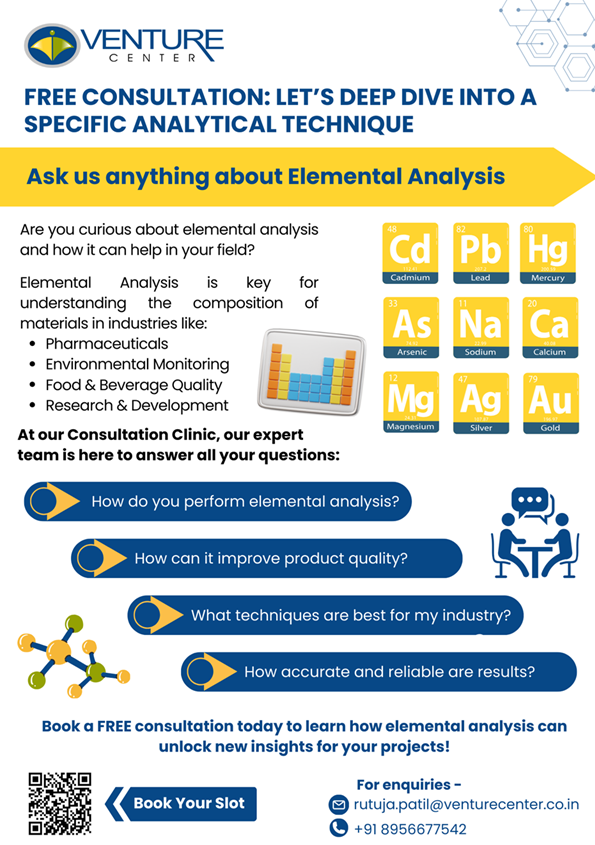Elemental analysis is a foundational technique used across disciplines—from food safety to environmental monitoring and materials science. This session, part of Venture Center’s "Only One Analytical Technique" talk series, delves deep into this powerful analytical method, exploring its significance, techniques, and real-world applications.
From the "Only One Analytical Technique" talk series by Venture Center. Watch the full video here -
https://www.youtube.com/watch?v=EHgdMtbYHRg&t=2s
Why Elemental Analysis Matters
Elements form the building blocks of all matter. Whether you're testing water for contamination, ensuring food safety, or developing new materials, understanding the elemental composition is key. For instance, incidents like the EU banning Indian spices due to heavy metal contamination and the 2015 Maggi noodles recall over lead content underscore the global importance of accurate elemental analysis.
What is Elemental Analysis?
Elemental analysis determines the types and quantities of elements in a sample. Beyond identifying elements, it can measure their concentration and even their isotopic ratios, using techniques like ICP-MS and IRMS.
Categories of Elemental Analysis:
- Classical Methods (Wet Chemistry):
- Gravimetric Analysis: Measures mass changes due to chemical reactions (e.g., determining sulfate via barium chloride precipitation).
- Volumetric Analysis: Measures volume changes in titrations (e.g., acid-base, redox).
- Instrumental Methods: These are now preferred for their speed and sensitivity. They include:
- Spectroscopic techniques
- Mass spectrometry
- X-ray based methods
- CHNS elemental analysis
Spectroscopic Techniques
Atomic Absorption Spectroscopy (AAS)
This method uses flame or graphite furnaces to atomize a sample, which then absorbs light at specific wavelengths. The light source (often a hollow cathode lamp) must match the element being measured.
- Flame AAS: Fast, robust, suitable for higher concentrations.
- Graphite Furnace AAS: More sensitive, lower sample volume needed.
Pros: High specificity, good sensitivity, cost-effective
Cons: One element at a time, regular maintenance, gas consumption
Optical Emission Spectroscopy (OES)
This technique includes:
- ICP-OES (Inductively Coupled Plasma): High-temperature plasma excites atoms, which emit light at characteristic wavelengths.ICP-OES provides high sensitivity and multi-element detection.
- MP-AES (Microwave Plasma): Nitrogen-based plasma, more eco-friendly.MP-AES uses atmospheric nitrogen, reducing operational costs.
ICP-MS: Inductively Coupled Plasma Mass Spectrometry
A step beyond OES, ICP-MS uses mass spectrometry for detection, offering the highest sensitivity and the unique ability to measure isotopic ratios.
Detector types: Quadrupole, Time-of-Flight (TOF), Magnetic Sector
Applications: Trace element detection, isotope analysis
X-ray Based Techniques
- XRF (X-ray Fluorescence): Non-destructive, minimal sample prep, ideal for solid and powder samples.
- XRD (X-ray Diffraction): Primarily used to determine crystal structure, not typically used for quantitative elemental analysis.
CHNS Analysis
Used for determining Carbon, Hydrogen, Nitrogen, and Sulfur content—mainly in organic samples. The sample is combusted, and the resulting gases are analyzed using a gas chromatograph.
Pros: Fast, accurate for organic content
Cons: Destructive, not suitable for inorganic materials
Choosing the Right Technique
Key considerations:
- Sample state: Solid, liquid, or gas?
- Elements of interest: Are you analyzing metals, organics, or isotopes
- Sensitivity required: For trace detection, ICP-MS is unmatched.
- Sample volume and throughput: High-throughput labs may prefer ICP-OES or MP-AES.
- Cost and maintenance: AAS is more economical; MP-AES reduces gas dependency.
Applications of Elemental Analysis Across Industries
- Food and Agriculture: Detecting heavy metals and nutritional content.
- Environment & Geology: Water testing, coal ash analysis, meteorite dating.
- Pharma and Materials Science: Quality control of tablets, polymers, ceramics, and biological samples.

Elemental Analysis Service at Venture Center
Venture Center houses a dedicated facility for elemental analysis using MP-AES. The team handles end-to-end workflows—from solid or liquid sample preparation to final analysis—making this essential service accessible for diverse industries and researchers.

